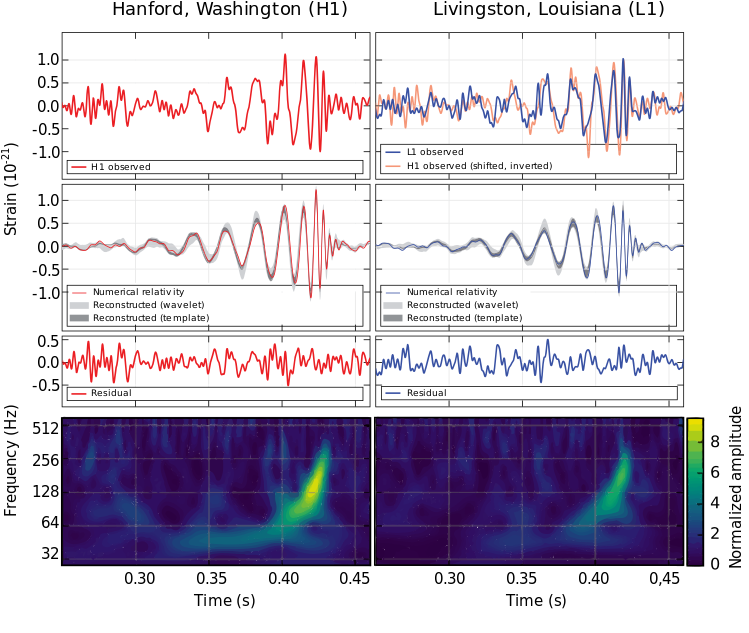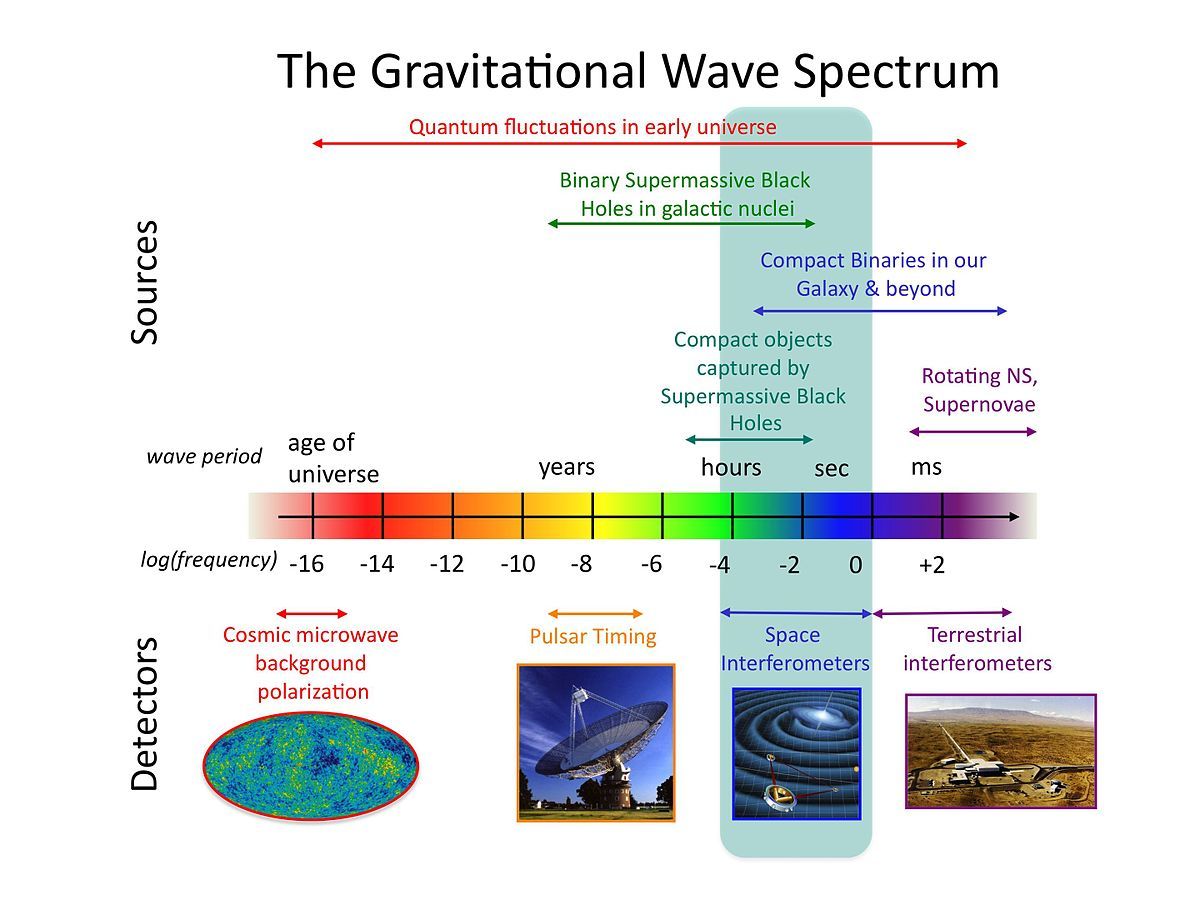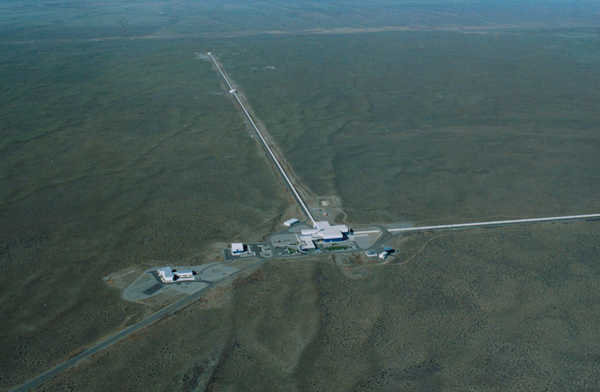



The first direct observation of gravitational waves was made on 14 September 2015 and was announced by the LIGO (Laser Interferometer Gravitational-Wave Observatory) and Virgo collaborations on 11 February 2016. Previously, gravitational waves had only been inferred indirectly, via their effect on the timing of pulsars in binary star systems. The waveform, detected by both LIGO observatories, matched the predictions of general relativity for a gravitational wave emanating from the inward spiral and merger of a pair of black holes of around 36 and 29 solar masses and the subsequent "ringdown" of the single resulting black hole. The signal was named GW150914 (from "Gravitational Wave" and the date of observation 2015-09-14). It was also the first observation of a binary black hole merger, demonstrating both the existence of binary stellar-mass black hole systems and the fact that such mergers could occur within the current age of the universe.
This first direct observation was reported around the world as a remarkable accomplishment for many reasons. Efforts to directly prove the existence of such waves had been ongoing for over fifty years, and the waves are so minuscule that Albert Einstein himself doubted that they could ever be detected. The waves given off by the cataclysmic merger of GW150914 reached Earth as a ripple in spacetime that changed the length of a 4-km LIGO arm by a thousandth of the width of a proton, proportionally equivalent to changing the distance to the nearest star outside the Solar System by one hair's width. The energy released by the binary as it spiralled together and merged was immense, with the energy of 3.0c2 solar masses (5.3×1047 joules or 5300 foes) in total radiated as gravitational waves, reaching a peak emission rate in its final few milliseconds of about 3.6×1049 watts – a level greater than the combined power of all light radiated by all the stars in the observable universe.
The observation confirms the last remaining directly undetected prediction of general relativity and corroborates its predictions of space-time distortion in the context of large scale cosmic events (known as strong field tests). It was also heralded as inaugurating a new era of gravitational-wave astronomy, which will enable observations of violent astrophysical events that were not previously possible and potentially allow the direct observation of the very earliest history of the universe. On 15 June 2016, two more detections of gravitational waves, made in late 2015, were announced. Eight more observations were made in 2017, including GW170817, the first observed merger of binary neutron stars, which was also observed in electromagnetic radiation.

LIGO measurement of the gravitational waves at the Livingston (right) and Hanford (left) detectors,...
Albert Einstein originally predicted the existence of gravitational waves in 1916, on the basis of his theory of general relativity. General relativity interprets gravity as a consequence of distortions in space-time, caused by mass. Therefore, Einstein also predicted that events in the cosmos would cause "ripples" in space-time – distortions of space-time itself – which would spread outward, although they would be so minuscule that they would be nearly impossible to detect by any technology foreseen at that time. It was also predicted that objects moving in an orbit would lose energy for this reason (a consequence of the law of conservation of energy), as some energy would be given off as gravitational waves, although this would be insignificantly small in all but the most extreme cases.
One case where gravitational waves would be strongest is during the final moments of the merger of two compact objects such as neutron stars or black holes. Over a span of millions of years, binary neutron stars, and binary black holes lose energy, largely through gravitational waves, and as a result, they spiral in towards each other. At the very end of this process, the two objects will reach extreme velocities, and in the final fraction of a second of their merger a substantial amount of their mass would theoretically be converted into gravitational energy, and travel outward as gravitational waves, allowing a greater than usual chance for detection. However, since little was known about the number of compact binaries in the universe and reaching that final stage can be very slow, there was little certainty as to how often such events might happen.
In Einstein's general theory of relativity, gravity is treated as a phenomenon resulting from the curvature of spacetime. This curvature is caused by the presence of mass. Generally, the more mass that is contained within a given volume of space, the greater the curvature of spacetime will be at the boundary of its volume. As objects with mass move around in spacetime, the curvature changes to reflect the changed locations of those objects. In certain circumstances, accelerating objects generate changes in this curvature, which propagate outwards at the speed of light in a wave-like manner. These propagating phenomena are known as gravitational waves.
As a gravitational wave passes an observer, that observer will find spacetime distorted by the effects of strain. Distances between objects increase and decrease rhythmically as the wave passes, at a frequency equal to that of the wave. This occurs despite such free objects never being subjected to an unbalanced force. The magnitude of this effect decreases in proportion to the inverse distance from the source. Inspiraling binary neutron stars are predicted to be a powerful source of gravitational waves as they coalesce, due to the very large acceleration of their masses as they orbit close to one another. However, due to the astronomical distances to these sources, the effects when measured on Earth are predicted to be very small, having strains of less than 1 part in 1020. Scientists have demonstrated the existence of these waves with ever more sensitive detectors. The most sensitive detector accomplished the task possessing a sensitivity measurement of about one part in 5×1022 (as of 2012) provided by the LIGO and VIRGO observatories. A space based observatory, the Laser Interferometer Space Antenna, is currently under development by ESA.

Gravitational waves can penetrate regions of space that electromagnetic waves cannot. They are able to allow the observation of the merger of black holes and possibly other exotic objects in the distant Universe. Such systems cannot be observed with more traditional means such as optical telescopes or radio telescopes, and so gravitational wave astronomy gives new insights into the working of the Universe. In particular, gravitational waves could be of interest to cosmologists as they offer a possible way of observing the very early Universe. This is not possible with conventional astronomy, since before recombination the Universe was opaque to electromagnetic radiation. Precise measurements of gravitational waves will also allow scientists to test more thoroughly the general theory of relativity.
In principle, gravitational waves could exist at any frequency. However, very low frequency waves would be impossible to detect and there is no credible source for detectable waves of very high frequency. Stephen Hawking and Werner Israel list different frequency bands for gravitational waves that could plausibly be detected, ranging from 10−7 Hz up to 1011 Hz.
In general terms, gravitational waves are radiated by objects whose motion involves acceleration and its change, provided that the motion is not perfectly spherically symmetric (like an expanding or contracting sphere) or rotationally symmetric (like a spinning disk or sphere). A simple example of this principle is a spinning dumbbell. If the dumbbell spins around its axis of symmetry, it will not radiate gravitational waves; if it tumbles end over end, as in the case of two planets orbiting each other, it will radiate gravitational waves. The heavier the dumbbell, and the faster it tumbles, the greater is the gravitational radiation it will give off. In an extreme case, such as when the two weights of the dumbbell are massive stars like neutron stars or black holes, orbiting each other quickly, then significant amounts of gravitational radiation would be given off.
Some more detailed examples:
More technically, the second time derivative of the quadrupole moment (or the l-th time derivative of the l-th multipole moment) of an isolated system's stress–energy tensor must be non-zero in order for it to emit gravitational radiation. This is analogous to the changing dipole moment of charge or current that is necessary for the emission of electromagnetic radiation.

Gravitational waves can be detected indirectly – by observing celestial phenomena caused by gravitational waves – or more directly by means of instruments such as the Earth-based LIGO or the planned space-based LISA instrument.
Indirect observation
Evidence of gravitational waves was first deduced in 1974 through the motion of the double neutron star system PSR B1913+16, in which one of the stars is a pulsar that emits electro-magnetic pulses at radio frequencies at precise, regular intervals as it rotates. Russell Hulse and Joseph Taylor, who discovered the stars, also showed that over time, the frequency of pulses shortened, and that the stars were gradually spiralling towards each other with an energy loss that agreed closely with the predicted energy that would be radiated by gravitational waves. For this work, Hulse and Taylor were awarded the Nobel Prize in Physics in 1993. Further observations of this pulsar and others in multiple systems (such as the double pulsar system PSR J0737-3039) also agree with General Relativity to high precision.
Direct observation
Direct observation of gravitational waves was not possible for the many decades after they were predicted due to the minuscule effect that would need to be detected and separated from the background of vibrations present everywhere on Earth. A technique called interferometry was suggested in the 1960s and eventually technology developed sufficiently for this technique to become feasible.
In the present approach used by LIGO, a laser beam is split and the two halves are recombined after travelling different paths. Changes to the length of the paths or the time taken for the two split beams, caused by the effect of passing gravitational waves, to reach the point where they recombine are revealed as "beats". Such a technique is extremely sensitive to tiny changes in the distance or time taken to traverse the two paths. In theory, an interferometer with arms about 4 km long would be capable of revealing the change of space-time – a tiny fraction of the size of a single proton – as a gravitational wave of sufficient strength passed through Earth from elsewhere. This effect would be perceptible only to other interferometers of a similar size, such as the Virgo, GEO 600 and planned KAGRA and INDIGO detectors. In practice at least two interferometers would be needed, because any gravitational wave would be detected at both of these but other kinds of disturbance would generally not be present at both, allowing the sought-after signal to be distinguished from noise. This project was eventually founded in 1992 as the Laser Interferometer Gravitational-Wave Observatory (LIGO). The original instruments were upgraded between 2010 and 2015 (to Advanced LIGO), giving an increase of around 10 times their original sensitivity.
LIGO operates two gravitational-wave observatories in unison, located 3,002 km (1,865 mi) apart: the LIGO Livingston Observatory (30°33′46.42″N 90°46′27.27″W) in Livingston, Louisiana, and the LIGO Hanford Observatory, on the DOE Hanford Site (46°27′18.52″N 119°24′27.56″W) near Richland, Washington. The tiny shifts in the length of their arms are continually compared and significant patterns which appear to arise synchronously are followed up to determine whether a gravitational wave may have been detected or if some other cause was responsible.
Initial LIGO operations between 2002 and 2010 did not detect any statistically significant events that could be confirmed as gravitational waves. This was followed by a multi-year shut-down while the detectors were replaced by much improved "Advanced LIGO" versions. In February 2015, the two advanced detectors were brought into engineering mode, in which the instruments are operating fully for the purpose of testing and confirming they are functioning correctly before being used for research, with formal science observations due to begin on 18 September 2015.
Throughout the development and initial observations by LIGO, several "blind injections" of fake gravitational wave signals were introduced to test the ability of the researchers to identify such signals. To protect the efficacy of blind injections, only four LIGO scientists knew when such injections occurred, and that information was revealed only after a signal had been thoroughly analyzed by researchers. On 14 September 2015, while LIGO was running in engineering mode but without any blind data injections, the instrument reported a possible gravitational wave detection. The detected event was given the name GW150914.

LIGO is made up of two observatories: one in Louisiana and one in Washington (above). Each observato...
When a gravitational wave passes by Earth, it squeezes and stretches space. LIGO can detect this squeezing and stretching. Each LIGO observatory has two “arms” that are each more than 2 miles (4 kilometers) long. A passing gravitational wave causes the length of the arms to change slightly. The observatory uses lasers, mirrors, and extremely sensitive instruments to detect these tiny changes.
GW150914 was detected by the LIGO detectors in Hanford, Washington state, and Livingston, Louisiana, USA, at 09:50:45 UTC on 14 September 2015. The LIGO detectors were operating in "engineering mode", meaning that they were operating fully but had not yet begun a formal "research" phase (which was due to commence three days later on 18 September), so initially there was a question as to whether the signals had been real detections or simulated data for testing purposes before it was ascertained that they were not tests.
The chirp signal lasted over 0.2 seconds, and increased in frequency and amplitude in about 8 cycles from 35 Hz to 250 Hz. The signal is in the audible range and has been described as resembling the "chirp" of a bird; astrophysicists and other interested parties the world over excitedly responded by imitating the signal on social media upon the announcement of the Discovery. The frequency increases because each orbit is noticeably faster than the one before during the final moments before merging.
The trigger that indicated a possible detection was reported within three minutes of acquisition of the signal, using rapid ('online') search methods that provide a quick, initial analysis of the data from the detectors. After the initial automatic alert at 09:54 UTC, a sequence of internal emails confirmed that no scheduled or unscheduled injections had been made, and that the data looked clean.After this, the rest of the collaborating team was quickly made aware of the tentative detection and its parameters.
More detailed statistical analysis of the signal, and of 16 days of surrounding data from 12 September to 20 October 2015, identified GW150914 as a real event, with an estimated significance of at least 5.1 sigma or a confidence level of 99.99994%. Corresponding wave peaks were seen at Livingston seven milliseconds before they arrived at Hanford. Gravitational waves propagate at the speed of light, and the disparity is consistent with the light travel time between the two sites. The waves had traveled at the speed of light for more than a billion years.
At the time of the event, the Virgo gravitational wave detector (near Pisa, Italy) was offline and undergoing an upgrade; had it been online it would likely have been sensitive enough to also detect the signal, which would have greatly improved the positioning of the event. GEO600 (near Hannover, Germany) was not sensitive enough to detect the signal. Consequently, neither of those detectors was able to confirm the signal measured by the LIGO detectors.

A schematic diagram of a laser interferometer.
REFERENCES
The Washington Post. Available in: https://www.washingtonpost.com/news/speaking-of-science/wp/2017/09/27/black-hole-collision-1-8-billion-light-years-away-sensed-in-u-s-and-italy/?noredirect=on&utm_term=.5ece5bdd36b5. Access in: 02/01/2019.
Cosmosmagazine. Available in: https://cosmosmagazine.com/space/gravitational-waves-biggest-black-hole-merger-ever-detected-revealed. Access in: 02/01/2019.
Nasa. Available in: https://spaceplace.nasa.gov/gravitational-waves/en/. Access in: 02/01/2019.
California Institute of Technology. Available in: https://www.ligo.caltech.edu/page/what-are-gw. Access in: 02/01/2019.
Encyclopædia Britannica. Available in: https://www.britannica.com/topic/Laser-Interferometer-Gravitational-wave-Observatory. Access in: 02/01/2019.
Wikipedia. Available in: https://en.wikipedia.org/wiki/Gravitational_wave. Access in: 02/01/2019.
Wikipedia. Available in: https://en.wikipedia.org/wiki/First_observation_of_gravitational_waves. Access in: 02/01/2019.

Default timespace